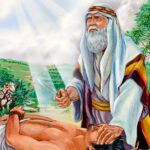The Book of 2 Chronicles is one of the most spiritually rich and historically profound books in the Old Testament. It continues the story where 1 Chronicles ends, focusing on the reign of King Solomon, the construction of the Temple in Jerusalem, and the successive kings of Judah until the Babylonian exile. Unlike the political focus of Kings, 2 Chronicles emphasizes spiritual faithfulness, divine worship, reform, and the consequences of disobedience.
At its core, 2 Chronicles is about kings and reforms — leaders who rose or fell based on their devotion to God, and the national revivals or declines that followed. This book remains relevant today because it reminds us that true leadership begins with faith, humility, and obedience to God’s Word.
Introduction to the Book of 2 Chronicles
The Book of 2 Chronicles was written as part of a unified historical account with 1 Chronicles, likely by Ezra the priest or another inspired writer from the post-exilic period (around 450–400 B.C.). It covers a span of approximately 400 years, from Solomon’s reign to the Babylonian exile in 586 B.C.
Understanding the Book of 1 Chronicles: Genealogy and Kingdom
While the Books of Kings tell both the history of Israel (the northern kingdom) and Judah (the southern kingdom), 2 Chronicles focuses exclusively on Judah — the kingdom from which the Messianic line of David would continue. The writer’s intent was to remind the returned exiles that national prosperity and divine favor depend on spiritual faithfulness.
The theme is clear: obedience brings blessing, and disobedience brings judgment.
Structure of 2 Chronicles
The book can be divided into two major parts:
- Chapters 1–9: The Reign of Solomon — Wisdom, wealth, and the building of the Temple.
- Chapters 10–36: The Kings of Judah — From Rehoboam to Zedekiah, highlighting reformers and apostates.
This structure helps us see how leadership and worship directly affected Judah’s spiritual destiny.
Understanding the Book of 1 Kings: Wisdom and Idolatry
Solomon’s Reign: Wisdom and Worship (Chapters 1–9)
a. Solomon’s Request for Wisdom
The book opens with Solomon succeeding David as king. His first act as ruler was not to expand his army or accumulate wealth — but to seek God’s wisdom.
“Give me wisdom and knowledge, that I may lead this people; for who is able to govern this great people of yours?” — 2 Chronicles 1:10
God was pleased with Solomon’s request and granted him wisdom, along with riches and honor. This story demonstrates that true leadership begins with dependence on divine guidance, not human intelligence or power.
b. The Building of the Temple
Solomon’s greatest achievement, both politically and spiritually, was the construction of the Temple in Jerusalem (2 Chronicles 2–7). This temple became the center of Israel’s worship, symbolizing God’s dwelling among His people.
Understanding the Book of 1 Samuel: Kingship and Transition
After years of careful planning and craftsmanship, Solomon dedicated the Temple with an elaborate ceremony, offering countless sacrifices and prayers of dedication.
“When Solomon finished praying, fire came down from heaven and consumed the burnt offering and the sacrifices, and the glory of the Lord filled the temple.” — 2 Chronicles 7:1
This divine manifestation affirmed God’s approval and presence in the Temple.
c. God’s Covenant with Solomon
After the temple’s dedication, God appeared to Solomon, renewing His covenant:
“If My people, who are called by My name, will humble themselves and pray and seek My face and turn from their wicked ways, then I will hear from heaven, and I will forgive their sin and will heal their land.” — 2 Chronicles 7:14
This verse captures the heart of 2 Chronicles — repentance and reform bring restoration.
Understanding the Book of 2 Kings: Judgment and Exile
However, God also warned Solomon that if he or his descendants turned away to worship other gods, He would uproot Israel and destroy the temple. Sadly, this warning would later come true.
d. Solomon’s Decline
Despite his great wisdom, Solomon’s later years were marked by compromise. His alliances through foreign marriages and tolerance of idolatry weakened the nation spiritually. This serves as an eternal reminder that spiritual decline often begins subtly — through divided loyalties and pride.
The Divided Kingdom: From Rehoboam to Zedekiah (Chapters 10–36)
After Solomon’s death, his son Rehoboam ascended the throne. His harshness and disregard for wise counsel led to a civil split — ten tribes formed the northern kingdom of Israel, while Judah and Benjamin remained loyal to David’s line in the south.
Understanding the Book of 2 Samuel: Kingdom and Sin
From this point on, 2 Chronicles focuses solely on Judah, emphasizing how each king either upheld or abandoned God’s covenant.
The Kings and Their Reforms
Throughout the history of Judah, certain kings stood out for their spiritual reforms — moments when the nation turned back to God after periods of corruption and idolatry. These stories reveal both the power of repentance and the danger of spiritual negligence.
Let’s examine a few key reforming kings:
a. King Asa: The Reforming Warrior (Chapters 14–16)
Asa, the great-grandson of Solomon, began his reign with zeal for God. He removed idols, commanded the people to seek the Lord, and fortified the nation spiritually and militarily.
“Asa did what was good and right in the eyes of the Lord his God.” — 2 Chronicles 14:2
When faced with a vast Ethiopian army, Asa prayed for help, declaring that victory belongs to the Lord. God delivered Judah, proving that faith triumphs over might.
Understanding the Book of Ezra: Restoration and Rebuilding
However, later in life, Asa relied on political alliances instead of God and even imprisoned a prophet who rebuked him. His story teaches that spiritual vigilance must last a lifetime — not just in times of crisis.
b. King Jehoshaphat: The Peacemaker (Chapters 17–20)
Jehoshaphat is remembered for promoting spiritual education across Judah. He sent priests and Levites to teach the Law, ensuring that the people understood God’s Word.
When a vast coalition of enemies attacked, Jehoshaphat sought God in prayer rather than battle.
“We do not know what to do, but our eyes are on You.” — 2 Chronicles 20:12
God responded with miraculous deliverance — the enemies destroyed each other while Judah praised God. This story underscores the power of worship in warfare and the victory of faith over fear.
c. King Joash: The Young Restorer (Chapters 23–24)
Crowned at age seven, Joash was guided by the priest Jehoiada, who helped him restore the temple and revive worship. As long as Joash obeyed God under Jehoiada’s counsel, he prospered.
Understanding the Book of Nehemiah: Leadership and Rebuilding
However, after Jehoiada’s death, Joash turned to idolatry and even killed the priest’s son who warned him. His tragic fall demonstrates the danger of second-hand faith — when obedience depends on others instead of personal conviction.
d. King Hezekiah: Revival and Restoration (Chapters 29–32)
Hezekiah was one of Judah’s greatest reformers. He reopened the Temple, purified it, and reinstated proper worship. He called the nation to celebrate the Passover, inviting even remnants from the northern tribes to join in repentance and unity.
“Hezekiah trusted in the Lord, the God of Israel. There was no one like him among all the kings of Judah.” — 2 Chronicles 31:20–21
When Assyria invaded, Hezekiah sought God’s deliverance through prayer. The Lord miraculously saved Jerusalem, showing that faith and reform bring divine protection.
e. King Josiah: The King Who Found the Law (Chapters 34–35)
Josiah began ruling at just eight years old but became one of Judah’s most faithful kings. During temple repairs, the Book of the Law (probably Deuteronomy) was discovered. Upon hearing it, Josiah tore his clothes in repentance and led a national reformation.
Understanding the Book of Esther: Providence and Courage
“Neither before nor after Josiah was there a king like him who turned to the Lord as he did—with all his heart and with all his soul and with all his strength.” — 2 Chronicles 34:33
Josiah’s revival reminds us that God’s Word is the foundation of reform.
4. Apostasy and Exile
Despite the efforts of righteous kings, Judah’s faithfulness did not last. After Josiah’s death, the nation fell into corruption and idolatry once again. The final kings — Jehoahaz, Jehoiakim, Jehoiachin, and Zedekiah — ignored prophetic warnings, desecrated the temple, and provoked God’s judgment.
“The Lord, the God of their ancestors, sent word to them through his messengers again and again… but they mocked God’s messengers.” — 2 Chronicles 36:15–16
The book ends with the Babylonian invasion, the destruction of the Temple, and the exile of Judah — a tragic fulfillment of God’s warnings.
Yet, even in judgment, hope remains. The final verses mention Cyrus of Persia, who allows the Jews to return and rebuild the Temple (2 Chronicles 36:22–23). This closing note of restoration foreshadows God’s unbroken covenant and mercy.
Theological Themes in 2 Chronicles
a. The Sovereignty of God: God rules over nations and kings. Every rise and fall of Judah’s rulers is a direct result of their relationship with Him.
b. Worship and Repentance: True reform begins with heartfelt worship and repentance. The nation’s spiritual health depended on the purity of its worship and obedience to God’s law.
Understanding The Book Of Job: Suffering And Sovereignty
c. The Role of Leadership: Righteous leaders like Hezekiah and Josiah brought revival; corrupt leaders like Manasseh and Zedekiah led the people into ruin. Leadership, therefore, is both a privilege and a spiritual responsibility.
d. The Consequences of Sin: The book consistently reinforces that sin leads to destruction, but repentance brings renewal.
e. The Hope of Restoration
Even in exile, God’s plan continues — pointing toward the coming of the Messiah, the true King who will bring lasting reform.
Lessons from the Book of 2 Chronicles and Relevance for Today
The Book of 2 Chronicles is not just ancient history; it is a spiritual mirror for believers and nations today.
- Leadership Must Reflect God’s Character – Rulers and ministers must lead with humility, justice, and a heart for reform.
- National Revival Begins with Repentance – As 2 Chronicles 7:14 declares, healing and restoration come when people humble themselves before God.
- Worship Is Central to Renewal – When worship becomes corrupt or neglected, spiritual decay follows.
- God’s Word Sparks Transformation – Every true reform begins with rediscovering and obeying Scripture.
- Hope Is Never Lost – Even after judgment, God offers restoration to all who seek Him.
Christ in 2 Chronicles
Throughout the book, we see glimpses of Christ’s kingship and redemption. Like Solomon, He is the wisdom of God. Like Hezekiah and Josiah, He brings revival and cleansing. And like the temple, He is the dwelling place of God among men.
“Destroy this temple, and I will raise it again in three days.” — John 2:19
Understanding The Old Testament: Genesis to Malachi
Christ is the perfect King who reigns with righteousness, bringing the ultimate reform — the transformation of the human heart.
Conclusion
The Book of 2 Chronicles teaches that the destiny of nations and individuals hinges on spiritual faithfulness. Through the stories of kings and reforms, we learn that God’s blessings flow where there is humility, obedience, and reverence.
From Solomon’s wisdom to Josiah’s revival and Judah’s exile, one truth shines: God’s mercy outlasts human failure. The call to reform remains timeless — to seek God, return to His Word, and restore true worship in our lives.
Last modified: November 10, 2025

